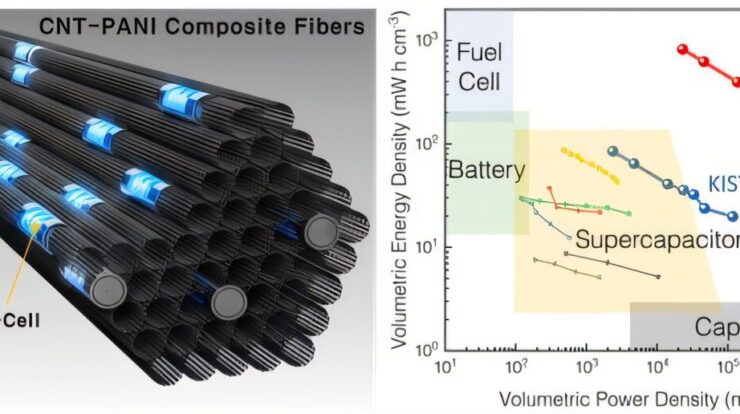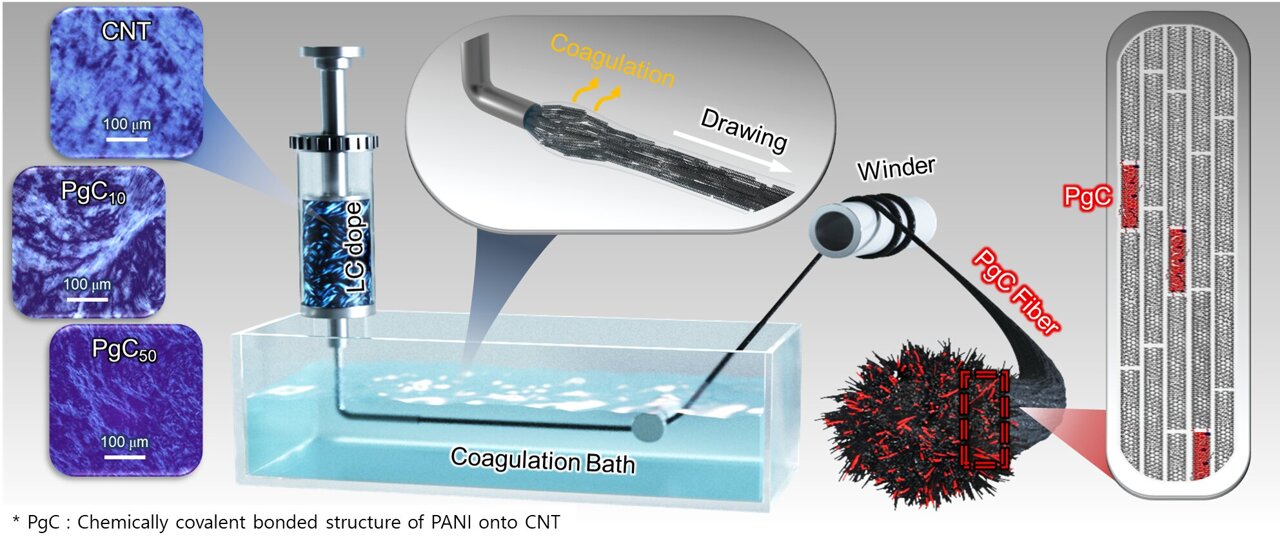
A research group has created a high-efficiency supercapacitor anticipated to be the future of energy storage systems. The specifics have now been revealed.
published
in the journal
Composites Part B: Engineering
The technology created by these researchers surpasses the constraints of current supercapacitors through the use of a novel fiber architecture made from single-walled carbon nanotubes (CNTs) combined with the electrically conducting polymer known as polyaniline (PANI).
Unlike traditional batteries, supercapacitors provide quicker charging and greater power density, with minimal deterioration even after tens of thousands of charge and discharge cycles. Nonetheless, they have lower energy density compared to regular batteries, which restricts their application for extended durations. This drawback has constrained their usage in real-world scenarios like electric cars and unmanned aerial vehicles.
Researchers led by Dr. Bon-Cheol Ku and Dr. Seo Gyun Kim of the Carbon Composite Materials Research Center at the Korea Institute of Science and Technology (KIST) and Professor Yuanzhe Piao of Seoul National University (SNU), uniformly chemically bonded single-walled carbon nanotubes (CNTs), which are highly conductive, with polyaniline (PANI), which is processable and inexpensive, at the nanoscale.

This generates a complex fiber architecture that boosts both electron and ion movement, leading to a supercapacitor capable of storing increased energy and discharging it more rapidly.
The advanced supercapacitor demonstrates consistent performance throughout over 100,000 cycles of charging and discharging, remaining robust under high voltage conditions. These features make this technology suitable as an alternative or supplement to conventional batteries. For instance, within electric cars, it enables rapid energy replenishment for enhanced efficiency, extending driving range and boosting overall vehicle performance.

Various technologies like drones and robots might see improvements with extended operation duration and enhanced dependability. Furthermore, the newly created composite material (CNT-PANI) boasts exceptional malleability; thus, it can undergo rolling and folding processes. This feature makes it suitable for incorporation into advanced electronics including wearables.
A significant accomplishment from this study is the decrease in production expenses along with the potential for large-scale manufacturing.
Even though they possess remarkable qualities, single-walled carbon nanotubes (CNTs) have struggled to become commercially viable because of their expensive manufacturing processes. However, the researchers tackled this issue by combining them with the cost-effective conductive polymer known as polyaniline (PANI).
Furthermore, they have laid the foundation for mass production through a simple process, and recently succeeded in developing film-like structures based on this technology, further advancing commercialization. In the future, it will be utilized as a key enabling technology for the transition to a carbon-neutral society across various industries, such as electric vehicles, robots, drones, and wearable devices.
Dr. Bon-Cheol Ku from KIST stated, “This technology addresses the limitations of supercapacitors through the use of single-walled carbon nanotubes and conductive polymers.”
“We will continue to develop and industrialize ultra-high-performance carbon fibers based on carbon nanotubes.”
More information:
Dongju Lee et al, Nanocell-structured carbon nanotube composite fibers for ultrahigh energy and power density supercapacitors,
Composites Part B: Engineering
(2025).
DOI: 10.1016/j.compositesb.2025.112179
Provided by National Research Council of Science and Technology
This tale was initially released on
Tech Xplore
. Subscribe to our
newsletter
For the most recent science and technology news updates.





